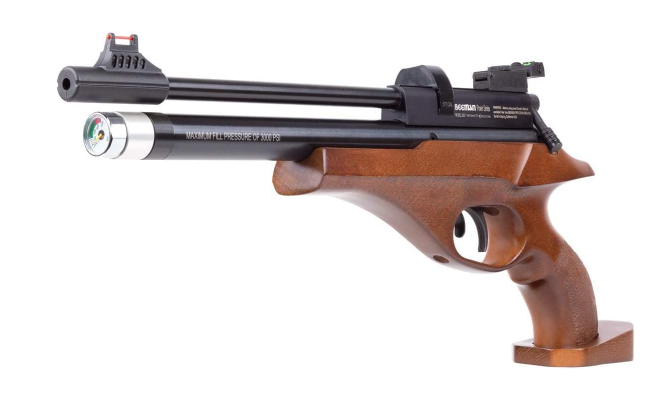Best Beeman Air Pistols are renowned for their precision engineering, reliable performance, and exceptional craftsmanship. Designed for shooters who demand accuracy and consistency, these air pistols combine modern innovation with durable construction to deliver outstanding results in target practice, pest control, and recreational shooting. Whether you prefer a powerful PCP model for competitive accuracy or a convenient CO₂-powered option for casual plinking, Beeman offers a wide range of air pistols to suit every shooter’s needs. Their attention to detail, ergonomic designs, and consistent shot performance make them a top choice among airgun enthusiasts worldwide.
Best Beeman Air Pistols
1.Springfield Armory 1911 Mil-Spec. CO2 BB Gun Air Pistol, 177 Caliber
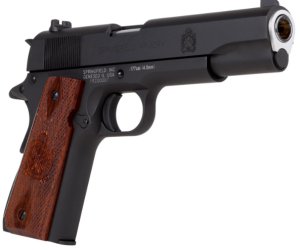
This full-metal 1911 Mil-Spec CO₂ BB pistol reproduces the look, weight and handling of the classic 1911 in a package built for range fun and realistic training. Chambered for .177 BBs with a 4.12″ barrel and a blowback slide, it pairs semi-automatic operation with convincing slide-kick realism, a hefty 2 lb feel, and straightforward controls — making it an attractive option for plinking, target practice, and those wanting an authentic 1911 experience without live ammunition.
The pistol’s metal construction and checkered faux-wood grips deliver a satisfying, well-balanced heft that mimics a service pistol. The blowback slide not only looks right but gives a tactile recoil impulse on each shot, improving the realism compared with non-blowback CO₂ pistols. With fixed 3-dot sights up front and a functioning grip safety plus thumb safety, it also provides several mechanical safeties and sighting simplicity for quick, steady target acquisition.
Ergonomically it’s built to feel familiar: a single-action trigger with a realistic break, working grip safety, and an ammo release and slide lock that mirror the controls of the firearm it reproduces. Powered by a single 12-gram CO₂ cartridge (tool/hex key included), the pistol feeds from a drop-free metal magazine that holds 18 BBs and can push BBs at up to 320 fps — fast enough for accurate plinking at typical backyard ranges. The manufacturer also advertises roughly 65 shots per cartridge fill, giving long shooting sessions between CO₂ changes depending on temperature and shooting cadence.
The heart of this model is its blowback CO₂ system, which does two things at once: it powers each shot and cycles the slide to produce a realistic recoil impulse. Unlike fixed-slide or non-blowback BB pistols, a blowback design gives a visible and tactile slide movement that adds to training value and enjoyment. For new shooters learning trigger discipline and follow-up shots, that kick helps teach timing and sight recovery the same way a firearm’s reciprocating slide would — but with far less energy and far greater safety when used responsibly.
Because the pistol uses a standard 12-gram CO₂ cartridge, setup is quick: insert the cartridge, engage the tool-free CO₂ pierce system, load the magazine and you’re ready. The semi-automatic cycle lets you concentrate on aiming and shot placement rather than manual cocking between rounds. The drop-free metal magazine and slide lock/thumb safety round out the feature set, giving you both fast reloads and the option to secure the pistol when not in use.
Do note that blowback pistols are typically a bit more gas-hungry than non-blowback designs — the slide movement consumes CO₂ each cycle — which is why advertised shot-counts per cartridge can vary. In typical conditions you can expect dozens of satisfying shots per fill, but cold weather and rapid strings will reduce that number.
Specifications
| Feature | Specification |
|---|---|
| Caliber | .177 BB (note: original spec lists “.117” in one line — assumed to be a typographical error) |
| Barrel Length | 4.12 in |
| Action | Semi-automatic, blowback slide |
| Power Source | One 12-gram CO₂ cartridge (tool/hex key included) |
| Muzzle Velocity | Up to 320 fps (manufacturer figure) |
| Magazine | Drop-free metal magazine, 18 BB capacity |
| Shots per CO₂ Fill | ~65 shots (advertised; real-world depends on temp/use) |
| Weight | ~2 lbs |
| Sights | Fixed 3-dot sights |
| Trigger | Single-action |
| Safety | Thumb safety, slide lock, functioning grip safety |
| Included | 1 metal magazine, hex key (no BBs included unless stated by seller) |
Pros
-
Realistic feel & operation — full-metal construction, blowback slide and 2 lb weight make it satisfying and authentic to handle.
-
Semi-automatic blowback gives convincing recoil impulse for training and enjoyable range use.
-
Easy to use — standard 12g CO₂ cartridges and tool-free activation make setup fast.
-
Good capacity for a pistol — 18-round drop-free magazine means fewer reloads during a session.
-
Multiple safeties — thumb safety, slide lock and functioning grip safety add user control.
-
Decent velocity for plinking — up to ~320 fps provides flat enough trajectory for casual target work.
-
Attractive styling — checkered faux-wood grips and metal finish give a premium look.
Cons
-
CO₂ consumption — blowback operation uses more gas per shot than non-blowback designs; cold weather reduces efficiency and velocity.
2.Beeman Protect BP50 .50 Caliber Orange Projectile Launcher CO2 Powered Air Pistol with 8 Pepper Balls and 8 Steel Balls – Non Lethal, Home & Personal Defense
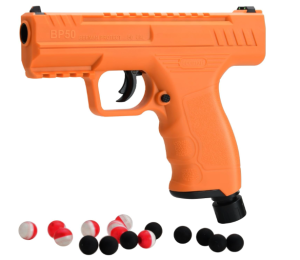
This Beeman offering is a semi-automatic CO₂ projectile launcher in .50 caliber designed for rapid follow-up shots without manual cocking. The 12-gram CO₂ power system and tool-free pierce/activation means fast setup and easy field use. With a 20+ shot capacity claimed (combining magazine + multiple projectiles per cylinder or multi-mag use as specified by manufacturer marketing), it aims to be a flexible option for casual range use, training scenarios, or non-lethal deterrence when loaded with pepper rounds.
The headline feature here is the semi-automatic .50-caliber CO₂ delivery system. Unlike single-shot pistols that force you to manually cock or load before each discharge, a semi-automatic action frees the shooter to focus on aiming and follow-up shots. In practical terms this means much faster strings of fire and reduced disruption when engaging multiple targets or practicing rapid target transitions.
Because it uses a 12-gram CO₂ cylinder with an integrated CO₂ pierce technology and tool-free quick activation, the operational workflow is simplified: insert the CO₂, engage the pierce with the supplied mechanism, and you’re ready to fire. That’s particularly helpful in training situations where downtime to swap power sources interrupts cadence, or in low-stress defensive drills where simplicity is a safety benefit.
Pairing that semi-automatic action with a .50 caliber projectile gives each shot greater energy and visible impact compared with smaller-caliber pellets — whether you’re using steel rounds for range impact or pepper balls for chemical-deterent effect. The included 8-round magazine provides immediate multi-shot capability and is complemented by the unit’s advertised 20+ shot capacity, which suggests multiple magazines or multiple rounds per CO₂ fill yield extended shooting before servicing is required.
Lastly, ergonomic and safety features such as an automatic trigger safety help mitigate accidental discharges while the compact 7.32″ footprint keeps the system handy and transportable. Overall, the semi-automatic CO₂ system is the central design decision that pushes this Beeman toward users who want speed, repeatability, and a heavier projectile than typical air pistols.
Specifications
-
Action: Semi-automatic
-
Caliber: .50 (0.50)
-
Muzzle Velocity: 385 fps (manufacturer figure)
-
Overall Length: 7.32 inches
-
Power Source: 12-gram CO₂ cylinder (CO₂ Pierce Technology; tool-free quick activation)
-
Magazine: Installed 8-round magazine (included)
-
Capacity: 20+ shots (advertised combined capacity)
-
Effective Range: Up to 150 feet (advertised)
-
Safety: Automatic trigger safety
-
Included Ammunition: 8 pepper balls and 8 steel balls included
Pros
-
Semi-automatic action enables fast follow-up shots and smoother target engagement.
-
Large-bore .50 projectiles deliver strong visible impact and increased energy vs. traditional pellet pistols.
-
CO₂ power + tool-free pierce makes setup quick and straightforward — good for rapid use or scenarios where simplicity matters.
-
Installed 8-round magazine lowers reload frequency; combined 20+ shot capacity means longer run times between magazine/CO₂ changes.
-
Compact overall length (7.32″) makes it easy to carry and manipulate.
-
Includes a mix of pepper and steel projectiles so you can test both non-lethal and impact rounds out of the box.
-
Automatic trigger safety reduces the chance of accidental discharge.
Cons
-
.50 caliber and 385 fps may still be loud and produce substantial recoil/impact for some users — not ideal for discreet backyard plinking.
3.Marshall .22 PCP Air Pistol
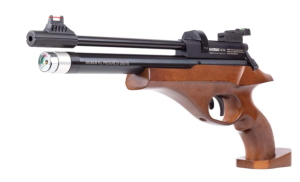
the Marshall is its PCP powerplant combined with a multi-shot magazine. Unlike single-stroke pneumatics or springers that require cocking between shots, the Marshall’s PCP reservoir stores compressed air (up to ~3,000 psi) and feeds a 10-shot cassette magazine, allowing rapid follow-ups with minimal change in point of impact across the useful pressure band. That consistency is vital for shooters working on groups or scoring targets at 10 m–25 m, and it also makes follow-up shots for small-pest dispatching more practical and humane.
Because the Marshall uses compressed air rather than CO₂, its performance is less sensitive to temperature swings and CO₂ depletion effects, producing tighter velocity spreads when properly regulated and filled. Many sellers and reviewers quote a typical advertised peak of up to ~600 fps in .22 with lighter pellets, but practical velocity and shot count will vary by pellet weight, fill pressure, and any tuning or velocity adjustment installed. In normal tuned use you can expect dozens of good shots per fill (manufacturers commonly claim ~60 shots at moderate power settings, though real-world numbers depend on how “hot” you run the pistol).
Ergonomically, the Marshall’s hardwood grip, palm shelf and textured surfaces give shooters a reference point for consistent hand placement, which synergizes with the PCP’s reduced recoil to make accurate groups easier to achieve. The combination of adjustable trigger, open fibre-optic sights and the option to mount optics on the dovetail rail makes the Marshall adaptable to both casual plinking and more focused target work.
Specification
| Spec | Detail |
|---|---|
| Model (common) | Beeman Marshall (Model 2028 — .22 cal). |
| Caliber | .22 (5.5 mm). |
| Action / Power | Pre-charged pneumatic (PCP), bolt action, multi-shot magazine. |
| Magazine | 10-round cassette magazine (typical). |
| Air Cylinder | ~50 cc, rated to 3,000 psi (206 bar) |
| Velocity (claimed) | Up to ~600 fps (varies by pellet weight / tuning). |
| Shots per Fill (advertised) | Up to ~60 shots (depends on power setting & pellet). |
| Overall Length | ~18″ (varies by configuration / stock). |
| Weight | ~3.75–4.8 lb (depending on wood stock/variant). |
| Sights / Mounting | Fiber-optic front, adjustable rear; 11 mm dovetail rail for optics. |
| Other | Adjustable trigger; front-mounted manometer / pressure gauge; single-shot tray and filling adapter usually included. |
Pros
-
PCP consistency — far more uniform velocities and less recoil than spring pistols, improving accuracy potential.
-
Multi-shot magazine — 10-shot cassettes give rapid follow-ups and reduce reloading interruptions during practice.
-
Good out-of-box feature set — fiber-optic sights, adjustable trigger, manometer, and dovetail for optics make it ready for target work.
-
Sporter ergonomics — hardwood grip and palm shelf encourage repeatable hand placement and comfortable shooting. Value proposition — reviewers note it sits between cheap spring pistols and expensive match PCP pistols in terms of performance vs. price.
Cons
-
Requires PCP filling gear — you need a hand pump, scuba tank adapter, or scuba/compressed air source to fill to 3,000 psi; that’s extra cost and logistics.
4..177 PCP Air Pistol
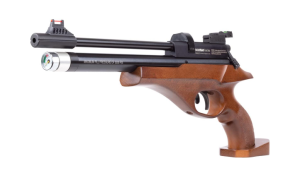
The Beeman 2027 .177 PCP Air Pistol is a pre-charged pneumatic air pistol designed to deliver exceptional accuracy and performance in a compact package. Powered by a 50cc air cylinder capable of holding up to 3,000 psi (206 bar) of compressed air, this pistol produces consistent velocity and minimal recoil, allowing shooters to achieve tighter groupings and repeatable results.
Built for versatility, the Beeman 2027 features a 12-round rotary magazine that enables rapid follow-up shots without the need for constant reloading. It also includes a single-shot tray, catering to precision shooters who prefer loading each pellet individually. With velocities reaching up to 600 fps, it’s perfect for target shooting, backyard plinking, and light pest control.
One of its standout features is the adjustable two-stage trigger, allowing shooters to fine-tune the pull weight for a cleaner, more predictable break. The pistol’s fiber-optic sights ensure quick target acquisition in various lighting conditions, and its 11mm dovetail rail accommodates optics such as red-dot sights or pistol scopes for enhanced accuracy.
Ergonomically designed with a hardwood grip and palm shelf, the Beeman 2027 offers a secure and comfortable hold, giving it the feel of a professional target pistol. The combination of solid construction, balanced weight, and smooth bolt action makes this air pistol ideal for both new shooters and experienced enthusiasts looking for a premium PCP sidearm.
The defining feature of the Beeman 2027 is its multi-shot PCP system, combining the power and consistency of a pre-charged pneumatic platform with the convenience of a 12-round magazine. Unlike single-stroke pneumatics or CO₂ pistols, the 2027 maintains a stable pressure curve throughout each shot string, resulting in consistent velocity and improved accuracy.
Its air reservoir is designed to provide up to 60 shots per fill, depending on pellet weight and power setting. The simplicity of a bolt-action mechanism paired with a reliable rotary magazine allows shooters to maintain focus on their target without frequent interruptions. This feature not only improves shot-to-shot consistency but also offers the convenience of quick follow-up shots — a rare quality in a compact PCP pistol.
Specifications
| Feature | Details |
|---|---|
| Model | Beeman 2027 PCP Air Pistol |
| Caliber | .177 (4.5 mm) |
| Power Source | Pre-Charged Pneumatic (PCP) |
| Fill Pressure | 3,000 psi (206 bar) |
| Air Cylinder Volume | 50 cc |
| Action Type | Bolt Action |
| Magazine Capacity | 12 Rounds (includes single-shot tray) |
| Velocity | Up to 600 fps |
| Shots Per Fill | Up to 60 (depending on setup) |
| Trigger | Adjustable Two-Stage Trigger |
| Sights | Fiber-Optic Front, Adjustable Rear |
| Optics Mount | 11mm Dovetail Rail |
| Overall Length | 18 inches |
| Weight | Approx. 3.8 lbs (1.7 kg) |
| Grip Material | Hardwood with Palm Shelf |
| Safety | Manual |
Pros
-
High Accuracy: Consistent PCP power system with minimal recoil ensures precise groupings.
-
Multi-Shot Capability: 12-round magazine allows rapid shooting without constant reloading.
-
Adjustable Trigger: Two-stage trigger lets users customize pull weight and travel for perfect control.
-
Excellent Ergonomics: Hardwood grip and palm shelf provide comfort and stability during long sessions.
-
Fiber-Optic Sights: Bright and adjustable sights offer fast target acquisition.
-
Quiet and Smooth: Less noise and vibration compared to CO₂ or spring-piston pistols.
-
Scope Ready: 11mm dovetail rail allows mounting of optics for enhanced precision.
-
High Shot Count: Up to 60 consistent shots per air fill makes it efficient for long practice sessions.
Cons
-
Requires PCP Filling Equipment: Needs a hand pump or compressor to refill the 3,000 psi air cylinder.
Also read;5 Best Umarex Legends Series Pistols
Factor to Consider when Choosing Best Beeman Air Pistols
1. Power Source
The first factor to consider when selecting a Beeman air pistol is the power source. Beeman offers models that run on CO₂ cartridges, spring-piston, or pre-charged pneumatic (PCP) systems. Each has distinct advantages. PCP pistols, like the Beeman 2027, provide consistent pressure and power for every shot, making them ideal for target shooting and accuracy. CO₂ models, on the other hand, are easier to use and convenient for casual shooters but may lose power in colder conditions. Spring-piston types require no external charging but tend to have more recoil and are single-shot only. Choosing the right power source depends on how often you plan to shoot and your experience level.
2. Accuracy and Consistency
Accuracy is the hallmark of any quality air pistol, and Beeman models are built for precision. A good Beeman pistol should feature a rifled barrel, adjustable sights, and an adjustable trigger to fine-tune your shooting experience. PCP air pistols offer superior consistency, as the compressed air system ensures each shot is released with uniform power. If you plan to use the pistol for target practice or small pest control, opt for a model that delivers tight groupings and allows optical attachments for enhanced aiming precision.
3. Caliber Selection
Beeman air pistols are available in different calibers, primarily .177 and .22. The .177 caliber is most popular for target shooting due to its higher velocity, flatter trajectory, and affordability. It’s ideal for paper targets and plinking. The .22 caliber provides heavier impact and more stopping power, making it suitable for small pest control and short-range hunting. Understanding your intended use will help determine which caliber best meets your performance needs.
4. Build Quality and Ergonomics
A durable construction and comfortable grip are essential in an air pistol. Beeman pistols are often built with solid metal frames, hardwood grips, or polymer bodies designed for balance and longevity. Ergonomics also play a major role—features like finger grooves, palm shelves, and contoured grips improve control and accuracy. The Beeman 2027, for example, features a hardwood grip with an adjustable palm shelf that ensures comfort during extended shooting sessions. Always consider how the pistol feels in your hand before making a purchase.
5. Trigger System
The trigger mechanism can greatly influence accuracy and overall shooting performance. Beeman pistols often feature adjustable two-stage triggers, allowing you to modify the pull weight and travel distance. A smooth, predictable trigger helps you release shots with minimal disturbance to your aim, resulting in tighter groupings. Beginners may prefer a factory-set trigger, while experienced shooters will appreciate models that let them fine-tune for competition-level precision.
6. Magazine Capacity and Loading Style
When choosing a Beeman air pistol, consider how many rounds it can hold and how they’re loaded. Models like the Beeman 2027 feature a multi-shot rotary magazine that holds up to 12 pellets, offering quick follow-up shots without constant reloading. Others are single-shot designs that prioritize accuracy over speed. Multi-shot options are excellent for plinking and rapid-fire practice, while single-shot versions are ideal for target shooters who value precision.
7. Air Efficiency and Velocity
The efficiency of air usage and velocity of pellets directly impact shooting performance. PCP pistols should provide multiple consistent shots per fill, often between 40–60 shots, depending on power settings. Higher velocity translates to flatter trajectories and better accuracy at longer distances. For example, the Beeman 2027 reaches speeds up to 600 fps, suitable for both paper targets and small pests. Always check the velocity and shot count to ensure it aligns with your shooting purpose.
8. Accessories and Customization Options
The ability to add accessories can enhance your shooting experience. Beeman air pistols often include 11mm dovetail rails for mounting optics like red-dot sights or pistol scopes. Some models also support suppressors, custom grips, and replacement triggers. Customization not only tailors the gun to your preferences but also improves comfort and performance. When choosing your Beeman pistol, look for models that offer flexibility for upgrades so your investment remains valuable as your skills grow.
Frequent Asked Question Best Beeman Air Pistols
1. What type of power plant should I choose (spring, CO₂, or PCP) for a Beeman air pistol?
When selecting a Beeman air pistol you will typically encounter three power types:
-
Spring-piston: Cocking a spring inside the pistol stores energy which is released with each shot. These are simple, require no external power source, and are often more affordable.
-
CO₂ powered: Uses small CO₂ cartridges to power shots. These are more convenient (just insert the cartridge and shoot) but performance can vary with temperature and cartridge status.
-
Pre-Charged Pneumatic (PCP): The pistol has a compressed-air reservoir that is filled (typically several thousand psi) and then allows multiple shots with consistent power and less recoil. Because of the reservoir, PCP models offer better shot-to-shot consistency and higher performance for target use.
Which you pick depends on your goals: casual plinking and convenience lean toward spring or CO₂; dedicated target-shooting or higher accuracy lean toward PCP.
2. How important is the caliber (.177 vs .22) for a Beeman air pistol?
Caliber is a key decision in air pistols including Beeman models:
-
.177 caliber (4.5 mm) is widely used for target shooting and plinking. It typically achieves higher velocity and a flatter trajectory, which helps for accuracy over moderate distances.
-
.22 caliber (5.5 mm) delivers heavier pellets, which means more impact energy and greater “punch” (useful for pest control or where stopping-power matters). The trade-off is slightly lower velocity and perhaps more drop over distance.
So if your goal is precision target work, go with .177. If you need more impact (e.g., for small game or pest control) then .22 may be more appropriate.
3. What maintenance and accessory considerations should I be aware of for a Beeman air pistol?
Maintenance and compatibility matter a lot in getting the best out of your Beeman pistol:
-
Ensure you use the correct pellets (caliber and quality) and avoid re-using damaged ones.
-
For PCP models: you’ll need a proper filling device or compressor to fill the air cylinder; poor filling or incorrect pressure can affect performance.
-
Trigger, sights, and mounting rails (if provided) are accessories to check — a pistol with adjustable trigger, optical mount or dovetail rail, and good grip ergonomics will serve better.
-
Regular cleaning, lubrication (where specified) and safe storage help maintain accuracy and longevity. For example, Beeman manuals stress reading safety/single-shot instructions and avoiding use of inappropriate gases.
-
Always check local laws/regulations for airguns in your region — they vary widely.
Conclusion
In conclusion, choosing the best Beeman air pistol comes down to understanding your personal shooting goals and preferences. Whether you prioritize accuracy, ease of use, or versatility, Beeman offers models designed to meet every need — from entry-level shooters to seasoned enthusiasts. Each pistol reflects the brand’s commitment to precision engineering, consistent power, and ergonomic comfort. By considering factors such as power source, caliber, trigger design, and customization potential, you can select a model that delivers dependable performance and long-term satisfaction for target shooting, training, or pest control applications.

